|
|

 The big disappointment: The Interchurch World Movement The big disappointment: The Interchurch World Movement Also: traditionalist America does not warm up to
this
new culture Also: traditionalist America does not warm up to
this
new culture Resisting this new culture was traditional "Old Time" Christian
religion Resisting this new culture was traditional "Old Time" Christian
religion
 Traditional
America celebrates America's great traditions Traditional
America celebrates America's great traditions
 Prohibition was Traditional America's way of opposing the New Culture Prohibition was Traditional America's way of opposing the New Culture
 But
"New America" had a way of striking back at Traditional America But
"New America" had a way of striking back at Traditional America Meanwhile
American cities come under increasing control by the
"mob" Meanwhile
American cities come under increasing control by the
"mob" American Xenophobia American Xenophobia
 American
Blacks also come under the same kind of ethnic hatred American
Blacks also come under the same kind of ethnic hatred
 A
sign of the times was the rapid growth of the Ku Klux
Klan A
sign of the times was the rapid growth of the Ku Klux
Klan The "Scopes Monkey Trial" – Dayton, Tennessee – 1925 The "Scopes Monkey Trial" – Dayton, Tennessee – 1925
 Christian
Fundamentalism vs. Christian Liberalism Christian
Fundamentalism vs. Christian Liberalism Even in urban America, cynicism afflicts the roar
of the Roaring 20s Even in urban America, cynicism afflicts the roar
of the Roaring 20s Freudian
psychology explains and justifies the American
mood Freudian
psychology explains and justifies the American
moodThe textual material on this webpage is drawn directly from my work America – The Covenant Nation © 2021, Volume One, pages 478-490. |

|
|
Caught in the changing mood of the times was a major project of Christian America, started up by the Foreign Missions Board of the Presbyterian Church just one month after the end of the war. Operating under the enthusiasm and the grand idealism that had the world looking forward to its entrance into a whole new post-war era (Wilson’s age of universal democratic peace), the idea was birthed of combining the efforts of a wide range of Protestant churches in their work abroad. The idea was that they all wanted the same thing, the world to be brought to Christ. So why not work together on this venture? The response to the invitation was amazing. Huge amounts of money towards the effort were pledged by the denominations, with the Methodists and the Baptists pledging ultimately to contribute around $100 million each toward the Fund. But sadly the shine on this highly idealistic post-war period quickly faded (even just by 1920), due to a number of factors, not only including the way the post-war world was cynically negotiated at Versailles but also because of a serious post-war recession that set in on the American economy. Only half of the pledged amount was actually raised, leaving the project vastly overextended and thus being forced to cut back deeply in its planning. But this coincided also with a general drop in Christian support across the nation, resulting in a loss of church attendance that gathered momentum as the 1920s advanced, which ran all the way into the 1930s. America was experiencing a deep existential challenge on all sorts of fronts, as the rather millennial expectations for a new world of universal peace, prosperity and cultural-spiritual dynamism faded from view. The 1920s rather quickly was proving itself to be quite something other than what the optimists, the progressivists, the idealists had been expecting.
|

|
|
The onset of a deep rural depression (early 1920s)
It must be noted that although the 1920s is regarded as the materialist age of the radio, the automobile, the home appliances, etc. that made American life so rich – these riches were concentrated largely in urban, and to a lesser extent in small-town America. They were largely lacking on the farms of rural America, where generally electricity had not yet reached. But that was the least of the problems faced by rural America during the 1920s. From the onset of the Great War in Europe in 1914 the demand for American farm goods skyrocketed as European farmers were taken away from their fields and put into uniform to fight in the trenches. Prices for American farm goods rose accordingly and the American farmer found himself to be something of a very successful businessman. Life was full of promise on the American farm. So, the farmer mortgaged his home and farm to buy more land – and machinery to work the land – in order to greatly expand his business. The profits rolled in – while the war lasted. Farm failures. When the Great War ended in late 1918, the good times of the American farmer ended as well. With European soldiers returning to their farms, Europe no longer needed American farm products, at least not in anywhere near the quantity that it needed them during the war. But the Americans had greatly expanded their operations and now a glut in the agricultural market appeared, and agricultural prices dropped away to nothing. Thus for example: wheat prices in 1919 were at $2.15 a bushel. The farmers were doing very well! But by the fall of 1920 the price had fallen to $1.44 a bushel. And by 1922 the price was down to 88 cents a bushel! Indeed, in his sales the American farmer hardly recovered the cost of producing his products much less make a profit or income for him and his family. But even worse, he owed huge amounts of money to the local banks that had lent him the money to buy all this additional land and machinery during the war. And he now had no way to pay back those loans or mortgages. One by one, farmers lost their land to the banks. Rural bank failures. But banks were not in the business of farming. Instead of money returning to them as payments for the loans and mortgages, the banks received in default the title to these failed farms. To recover their money, they could sell these farms – but to whom? And when they did it was always for far less than the money that they themselves had originally invested in the mortgages and loans to the farmers. So it was that the farmers' troubles were simply passed on to the banks. Thus in the early 1920s, the rural banks began also to fail one by one. Deep misery set in on rural America. Thus for rural America, the 1930s "Great Depression" had already arrived – ten years early. And rural America would not really come out of this situation during the rest of the decade – at which point the rest of the American economy would join rural America in the misery known as "The Great Depression." |
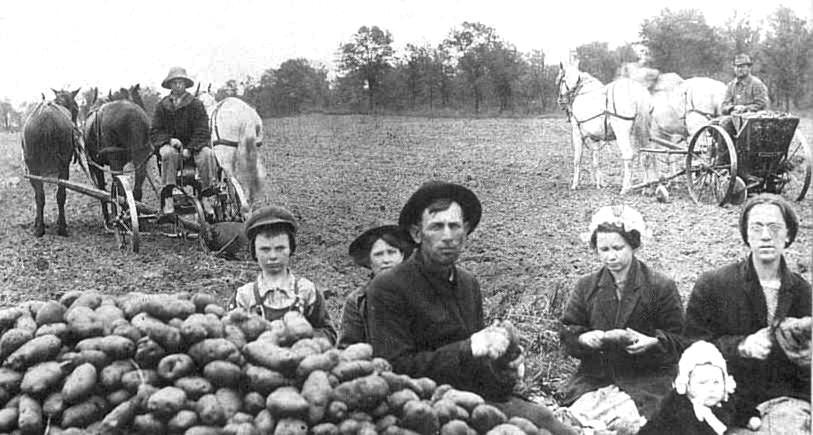
Minnesota potato farmer - 1920s
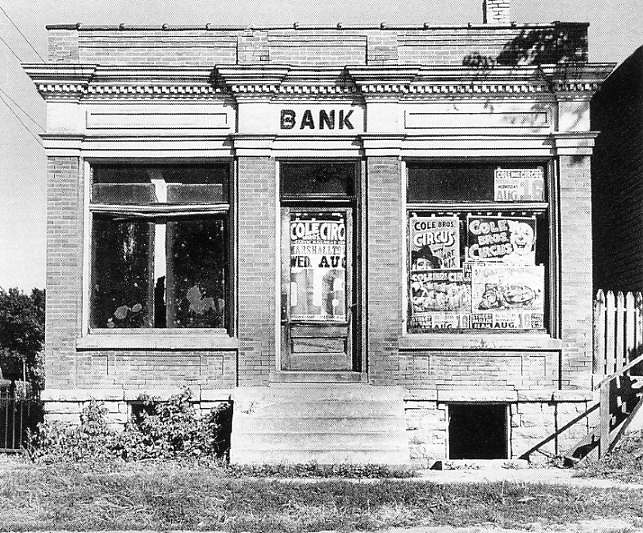
A closed bank – a typical
sight in 1920s rural America
(Tragically, my grandfather, a bank president, experienced the same catastrophe)
|
The growing American rural-urban cultural divide
And to further deepen the misery, watching the
wealth and fun gravitate to urban America in the 1920s only made
spirits worse in rural America. This economic divide unfortunately also
happened to coincide with a growing cultural divide between rural and
urban America. The rural side of this cultural divide was well-founded
on the traditional, White Anglo-Saxon Protestant (WASP) population and
ethic that had been at the core of American culture since the nation's
founding in the early 1600s as a group of English colonies. On the
urban side of the divide was a smaller, but growing ethic of immigrant
cultures, Catholic, Jewish and secular Socialist, accompanying recently
arriving immigrants from Europe – joined by Blacks migrating to
northern cities from the rural American South. By the 1920s WASPs felt
out of place in the American city, foreigners in their own land. While the American countryside felt most
comfortable and consoled itself with tradition, the cities were
bubbling with a sense of change. This sense of change, of new
possibilities, is what also brought WASPish intellectual Idealists to
the cities, where they felt that they had greater freedom to explore
social ideas that were considered largely taboo in the traditional
countryside that they had been born and grew up in. A rather
condescending attitude toward rural America began to register itself
among these liberated intellectuals – adding considerably to the
growing American cultural divide.
|

|
"Old Time" Christian religion considered
the preservation
of the old values and ways a matter
of strict Godliness
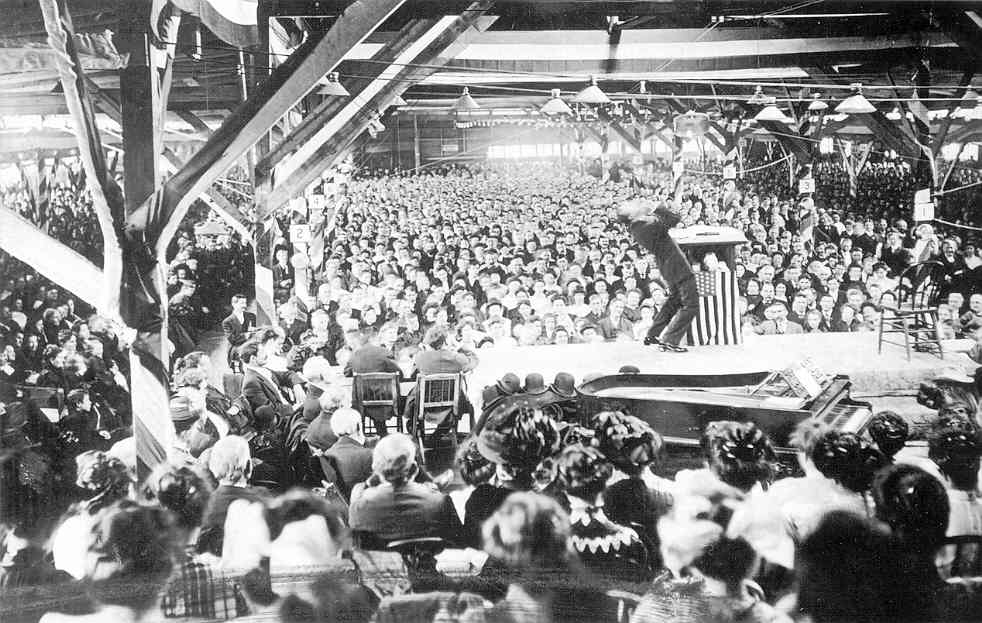
Billy Sunday revival -
1920s
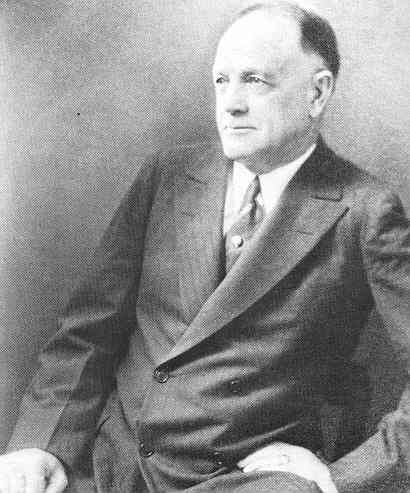
Billy Sunday

|
Assembling the Lincoln statue
in the Lincoln Memorial, Washington, D.C.- 1922
National Archives

|
|
Prohibition
Then there was this matter of the issue of the prevention or prohibition of the drinking of alcoholic beverages, an issue that divided America deeply. Perhaps most galling to rural America was the proliferation in urban America of the speakeasies (illegal bars), operating in brazen defiance of the new Eighteenth Amendment to the Constitution outlawing alcoholic beverages. WASPish rural and small-town America, especially the feminine portion of it, had actually for quite some time taken up arms against one of the great sins of men, the excessive drinking of alcoholic beverages. WASPish Christian morality had always been negative about alcohol, especially its easy ability to lead to drunkenness and alcoholism, which were most definitely great sins. But immigrants coming from Europe – Irish, Germans, Italians, Polish, etc. – seemed not to have this anti-alcohol ethic, alcohol being part of their daily diet. These immigrants for the most part upon
their arrival were consigned to urban or industrial slums, farmland no
longer being free for the taking from the Indians (the frontier had
finally closed with the last Indian lands claimed by White frontiersmen
farmers in the late 1800s). These immigrants were forced to find jobs
in mines and factories where there was a great need for unskilled
labor. But working conditions were terrible, the wages minimal, and
life (to quote Hobbes) nasty, brutish and short. Men looked forward to
payday when they could stop at the corner tavern on their way home from
work and drown their sorrows in the bliss of alcohol. Their wives of
course were upset that with things as troubled as they were, to have
that money go to a drunken spree was heartbreaking. This whole scenario
was one of deep tragedy. Temperance (moderation) easily turned into total prohibition as the best solution to the problem. And so a movement began to actually place this reform of total prohibition of the drinking of alcoholic into the Constitution as one of its amendments. And indeed, in early 1919 Prohibition took effect with the passing of the Eighteenth Amendment. |
WCTU float calling for support
of Prohibition Amendment
A Revenue Agent posting notice
that this bar has been closed
A Revenuer dumping booze
in conformity with the 18th Amendment
which went into effect on
January 29, 1920
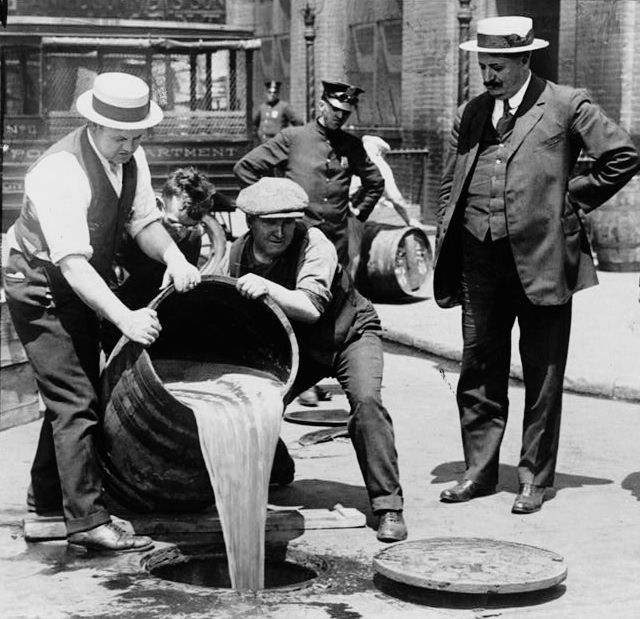
Dumping
booze
Federal agents dumping whiskey
down a sewer – 1920s
Destroying Beer -
1924
Destroying bootleg liquor
- early 1930s

|
|
Urban Resistance to Prohibition
But urban-industrial culture did not
take well to this imposed reform. It was understood (probably
correctly) as simply a slap in the face of urban America by rural
America – and urban America decided to strike back with a loud and very
visible defiance of this law. Indeed, the culture that Prohibition was
aimed at, urban America, seemed to actually increase its alcoholic
consumption behind the closed doors of the speakeasy bars, which
everyone (including the police) knew about quite readily.
The fast, easy money to be earned by the sale of illegal liquor (and
other social services!) naturally led to the growth of a large, wealthy
and very violent social structure: the "mob," constructed heavily along
the lines of the Italian (actually Sicilian) Mafia, although the Irish
and others also had their versions of the mob. Police and judges were
paid to look the other way, and in general urban America turned into an
even greater affront to the moral sensitivities of WASPish America. And
the cities loved the pained outcries of rural America. Prohibition had
become the gauntlet thrown down in the growing urban-rural cultural
divide impacting the nation.
|
Brooklyn, New York:
Kids trying to retrieve wine dumped into the streets by Federal
agents
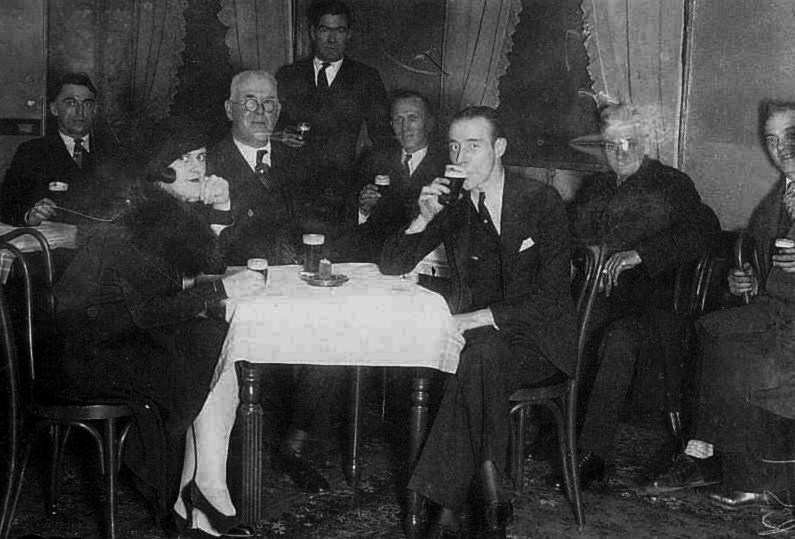
A 1920s Speakeasy
A flapper advertising her
support of the repeal of the 18th Amendment
Library of
Congress
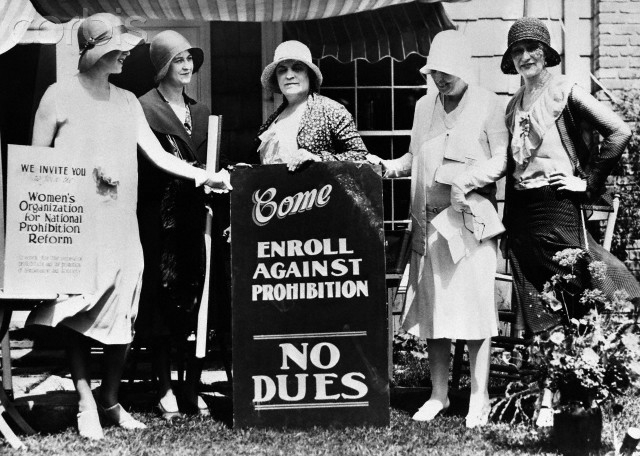
Prohibition "reformers"
Men marching for Repeal
New York speakeasy hostess
Texas Guinan being escorted into a Paddy Wagon
The arrest was a charade – because
her connections with the Democratic boss James
Hines would always bring about her immediate
release at police headquarters.

|
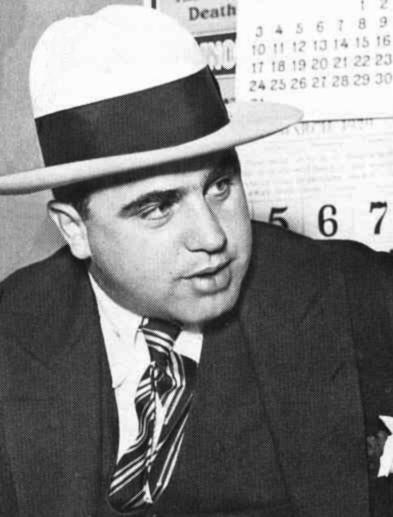
"Scarface" Al
Capone
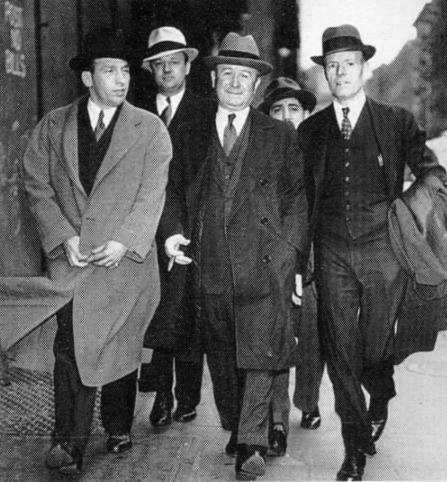
Johnny Torrio, Capone's mentor
in Chicago gang action -
who subsequently retired
and turned his operations over to Capone.
He has just posted bail
on federal charges
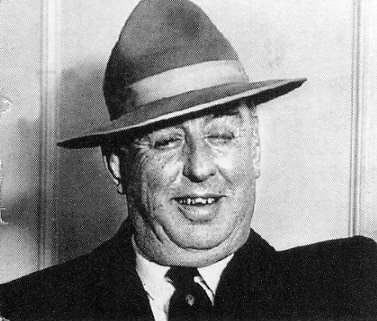
Chicago three-time Mayor
Bill Thompson – who was an ally of Al Capone's
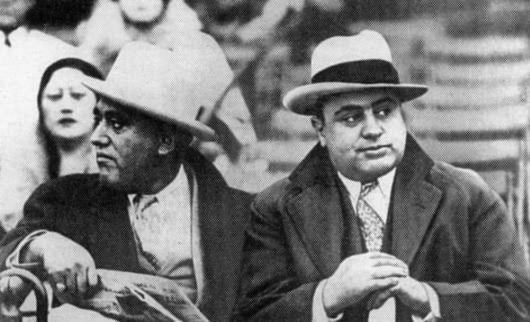
Al Capone at a baseball game
with former Chicago Alderman A.J. Prinano – 1931
Al Capone and a baseball
signing – 1931
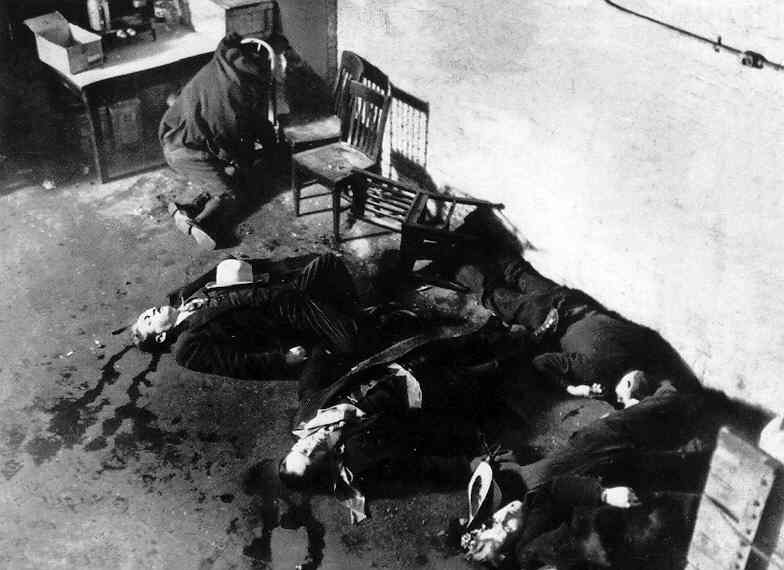
St. Valentine's Day massacre
of Chicago mobsters by enemy mobsters
St. Valentine's Day massacre
ordered by Al Capone
of gangsters of the rival
Bugs Moran gang in Chicago – February 14, 1929
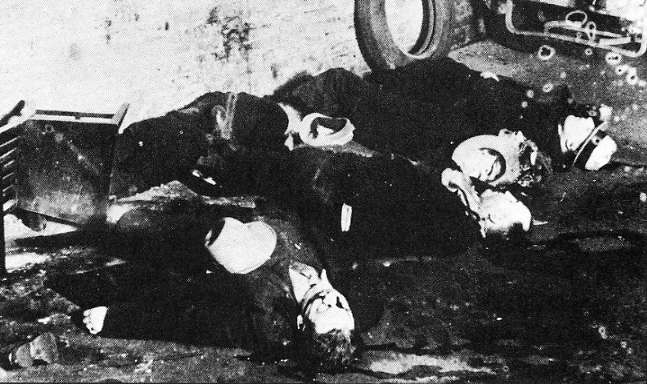
The Chicago gangland slaying
of rival gang members on St. Valentine's Day – 1929
Attempting to combat this
crime streak was a crime-fighter who would eventually
become a legend as the head
of the FBI: J. Edgar Hoover
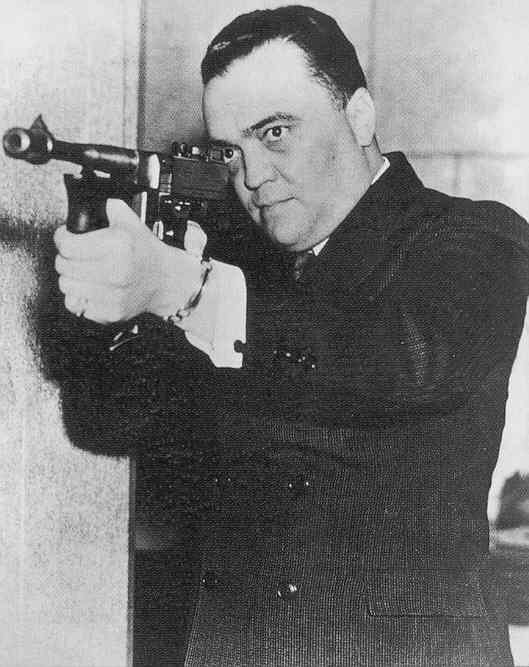
J. Edgar Hoover who took over the FBI in 1924 at a age 29

|
|
Understandably, America was a very attractive society ... drawing Europeans of all variety to the land where supposedly "the streets are paved with gold"! And America had always been a society of immigrants. Consequently, there were very good ways to bring immigrants into American society on a well regulated basis.
|
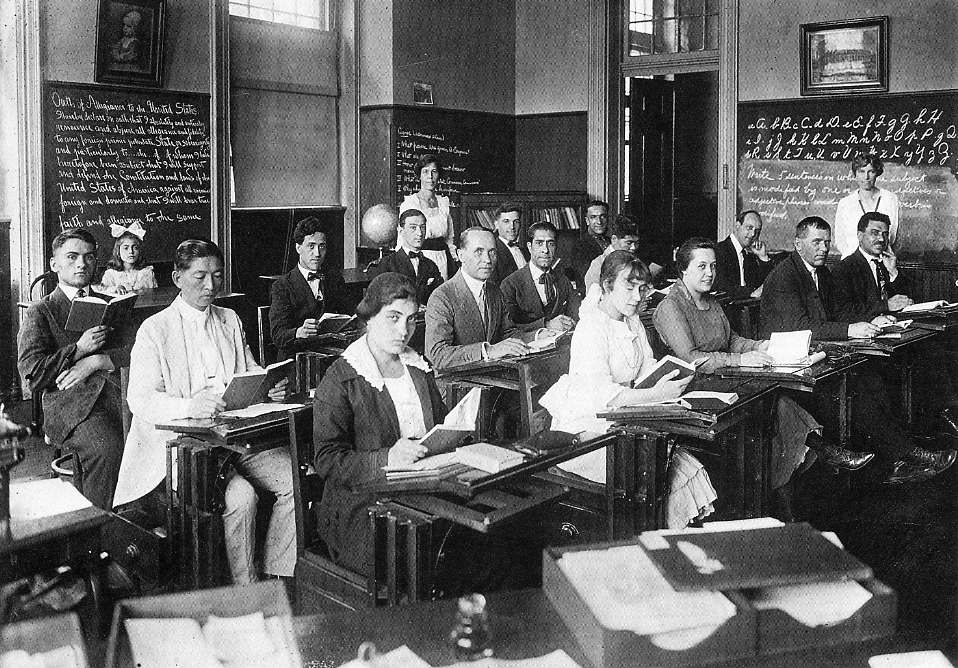
Washington, DC, immigrant-naturalization school – 1920s
|
Nonetheless, the flood of Europeans to America after the trauma of the Great War was upsetting a lot of Americans ... who saw this simply as an invasion of outsiders. They were not happy! Along similar lines, immigrants in general become a target of traditionalist America after the war, being by this time mostly: 2) religiously – Roman Catholic or Eastern Orthodox 3) politically – often sympathetic to one or another of the disgruntled European workers movements of Socialism, Communism, or even Anarchism
|
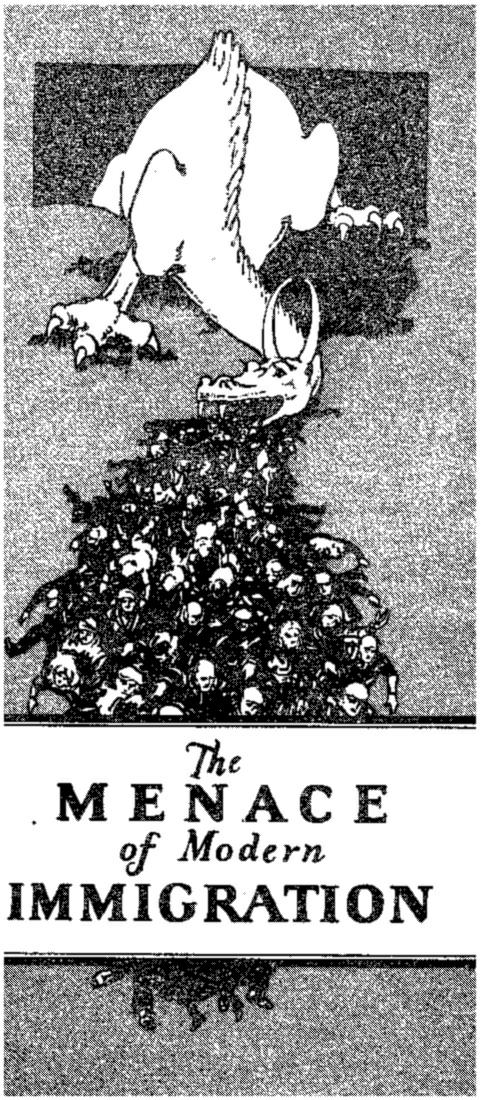
The menace of modern
immigration:
An address outlining fully the policies
of the Knights of the
Ku Klux Klan – by H. W. Evans, 1924.
|
The Great "Red Scare" in America. Relating closely to this mood of xenophobia was the huge Red Scare
Relating closely to this mood of xenophobia was the huge Red Scare that captured the imaginations of Americans (urban as well as rural) after the war, and into the first part of the 1920s. This was not without cause, however. Not only was this fear inspired by the spectacle of European societies caught up in class warfare – inspired by a spreading Communist urge of an angry European working class as well as an equally aggressive spirit of anarchism, the close cousin of Communism – but also by a similar social agitation which seemed to be brewing in America itself, especially among recent immigrants to America’s cities from Southern and Eastern Europe. It was no secret that from Southern Italy
came a large number of followers of the Italian anarchist Luigi
Galleani, who brought with them their radical political instincts. At the forefront of the movement to stop such radical violence was Wilson’s Attorney General, Mitchell Palmer. Although he started out cautiously in his campaign against foreign agitators, he turned savagely against immigrants suspected of radical views after his home was blown up (along with the bomber himself, the Galleanist, Carlo Valdinoci). Palmer hired 24-year-old J. Edgar Hoover to gather evidence and lead raids against such radicals. Files were gathered on 60,000 people and thousands were actually arrested in the period between November 1919 and February 1920. However, Palmer's plans for a presidential bid (his activity was making him a popular public figure) crumbled when a major Red uprising he predicted for May 1, 1920 failed to materialize.1 Then on September 16, 1920 a massive bomb exploded in the busy street in front of the Wall Street offices of the J.P. Morgan bank, killing 30 people and injuring 150 others (8 of whom would also die of their wounds). Although there was no precise evidence identifying the perpetrator of this vile event, suspicions were directed toward an Italian Galleanist anarchist, Mario Buda (verified as indeed the culprit 35 years later by a fellow anarchist and by Buda's nephew) who soon returned to Naples and thus was never apprehended.2 Americans were shocked. 1May Day had long been the chief holiday of the Socialist Labor Movement in Europe. 2This was apparently a Galleanist retaliation (the first of many to follow) for the arrests of Sacco and Vanzetti.
|
Wilson's Attorney General Mitchell Palmer
The anarchist Wall Street bombing - September 16, 1920
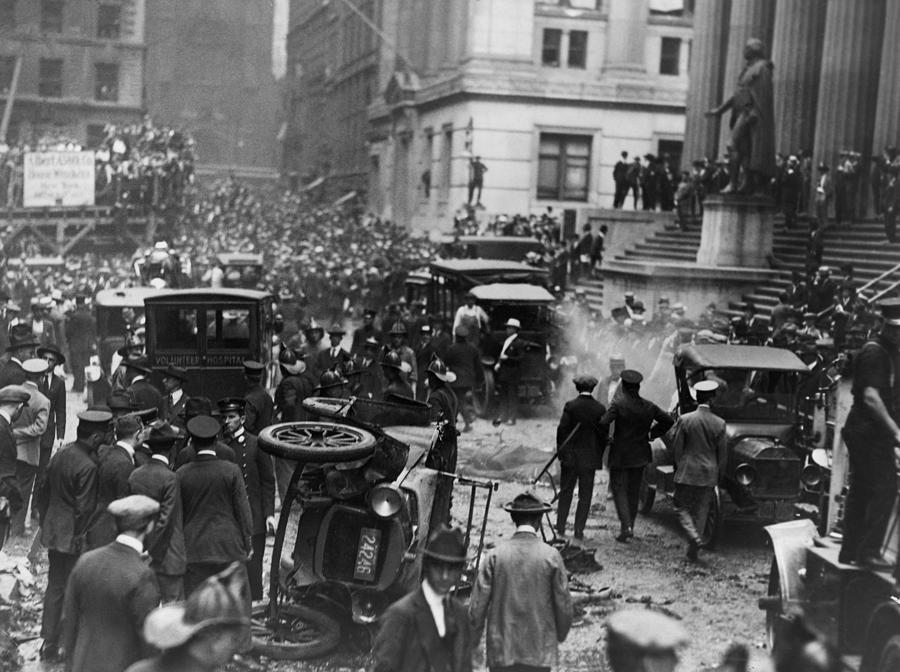
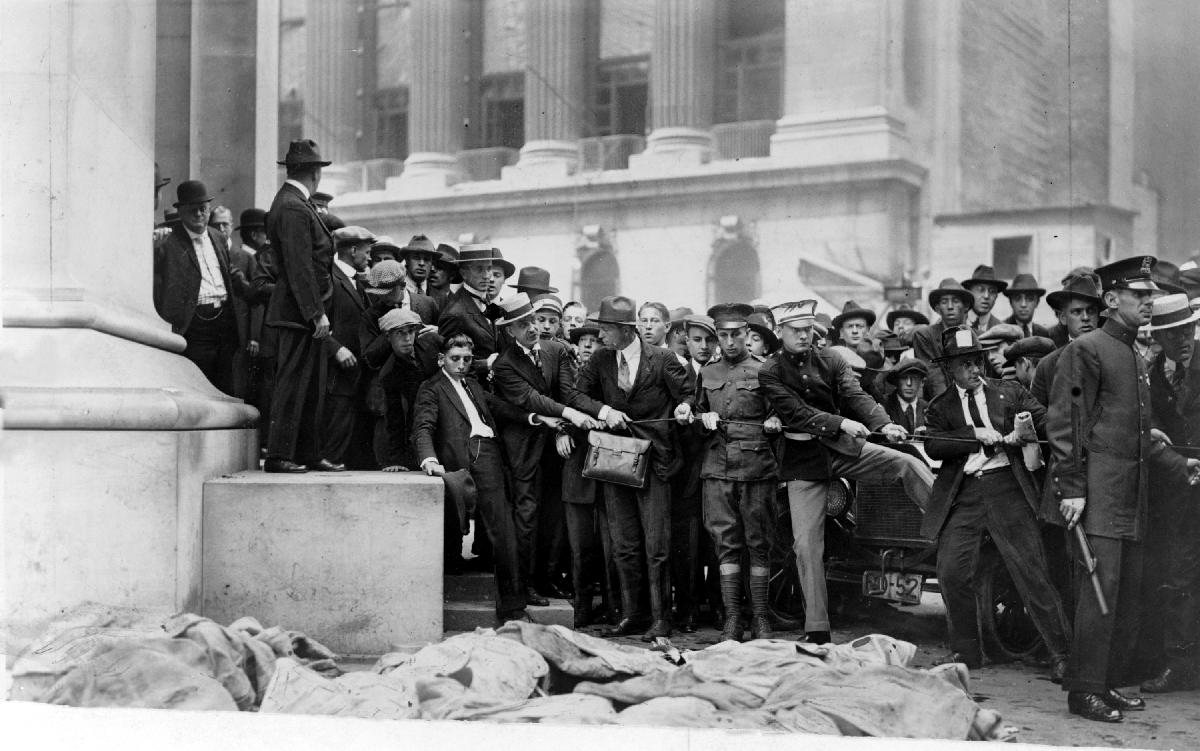
|
The Sacco and Vanzetti trial
Another event was to rock the nation, not just in 1920 when the event occurred, but over the next seven years as the nation – and even the world – debated the event and the way it was handled by the American justice system. On April 15, 1920 robbers held up and killed one of two men transporting the company payroll of the Slater Morrill Shoe Company in Braintree, Massachusetts. Suspicions went immediately to a group of local Galleanist anarchists, of whom Nicola Sacco and Bartolomeo Vanzetti were arrested and charged with the crime. The only real evidence to work with were the casings of bullets used in the attack. Testimonies by witnesses were confused and claims were made that the police had manipulated the evidence. Also there was a rush to judgment by the presiding judge, which later would become a major point of those who claimed that the two men were unfairly tried and sentenced for the murder the following summer (July 1921). Almost immediately the court case became something of the case of the century. Writers, academics and even artists got into the act, protesting the probable innocence of the two Italians, citing the growing xenophobia (fear/hatred of foreigners) of Americans as the only driving force behind the conviction. For the next six years the case was debated widely as the case was appealed through the American court system. Even the world got in on the act. Americans were widely understood to be cowboys when it came to justice, and the assumption arose that this was all nothing more than a typical vigilante lynching for which Americans were famous. Even the Pope intervened on Sacco and Vanzetti's behalf, asking Americans to check their motives. Then when finally in 1927 the sentence of death was issued for the two accused, protests (even riots) broke out in a number of the world's major cities. Nonetheless in August of 1927 the two were put to death in the electric chair.3 3The
case continued however to draw the interest of journalists, artists and
political activists over the decades that followed. In 1977 the liberal
Massachusetts Governor Michel Dukakis issued a formal proclamation that
the case was clearly unjust and that Sacco and Vanzetti's names should
be cleared of the crime. However subsequent statements (most recently
in 2005) by Italian colleagues of both men made it fairly clear that
Sacco had indeed done the shooting and Vanzetti had been involved …
though only in the robbery portion of the event.
|
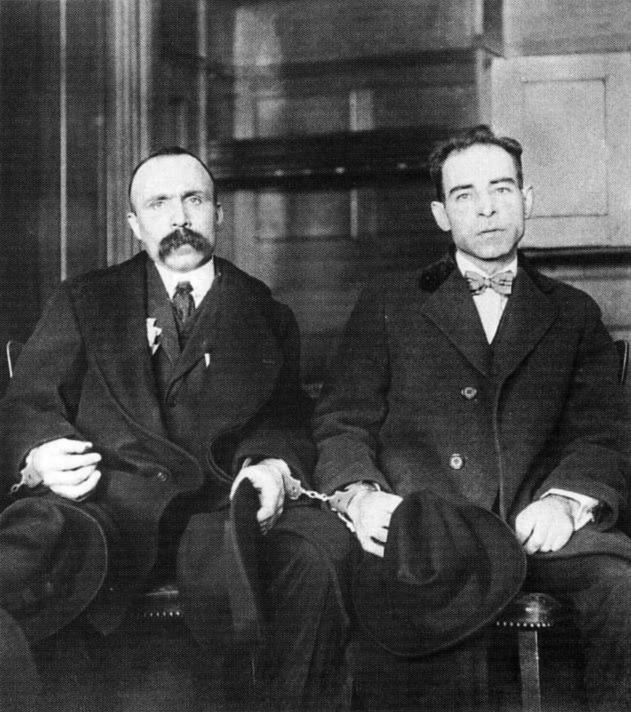
Nicola Sacco and Bartolomeo
Vanzetti
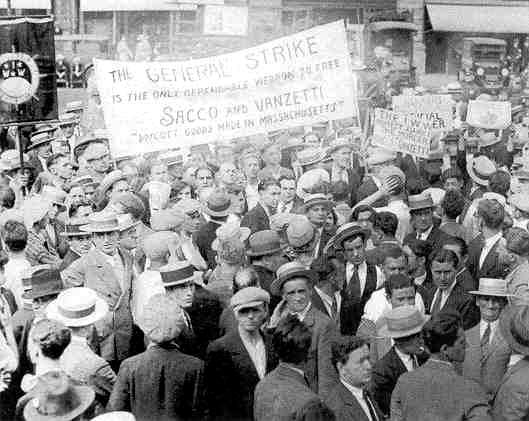
Protest in NYC over the Sacco and Vanzetti trial – 1921
The Case of Sacco and Vanzetti
in Cartoons from The Daily Worker. – Fred Ellis, 1927.
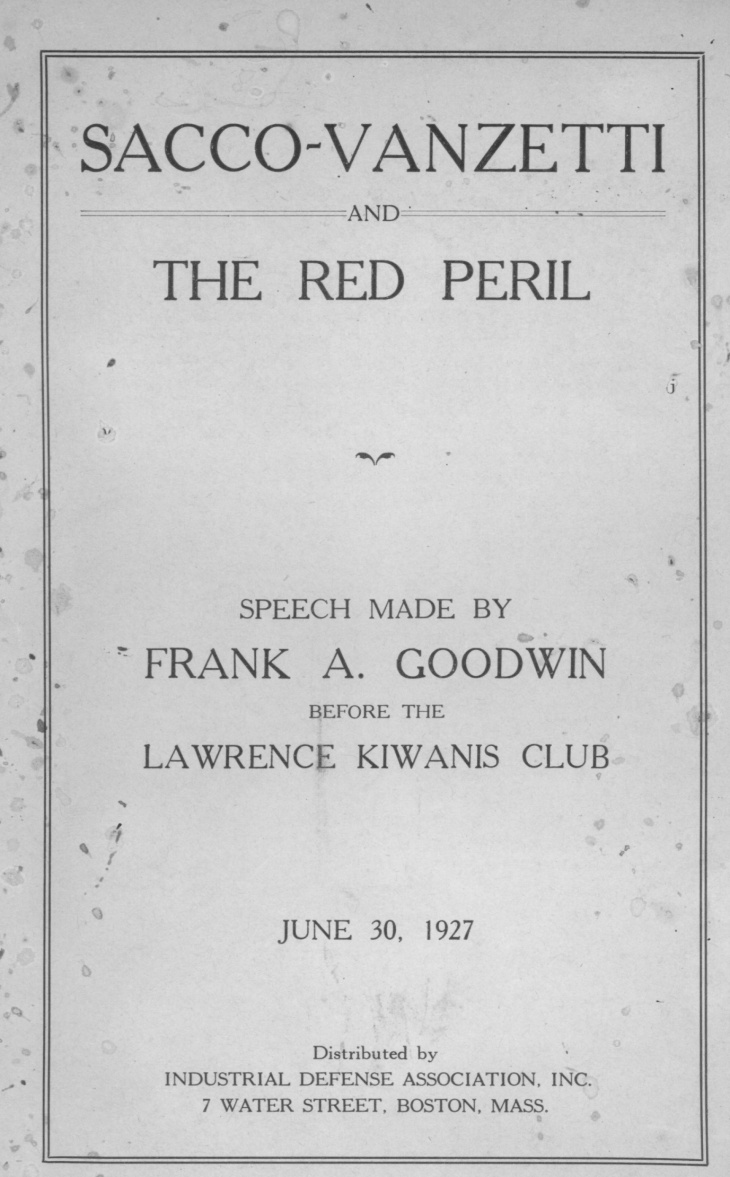
"Sacco-Vanzetti and
The Red Peril" – Frank A. Goodwin – 1927
The industrial labor movement – particularly with its
European Socialist roots –
also comes under deep suspicion
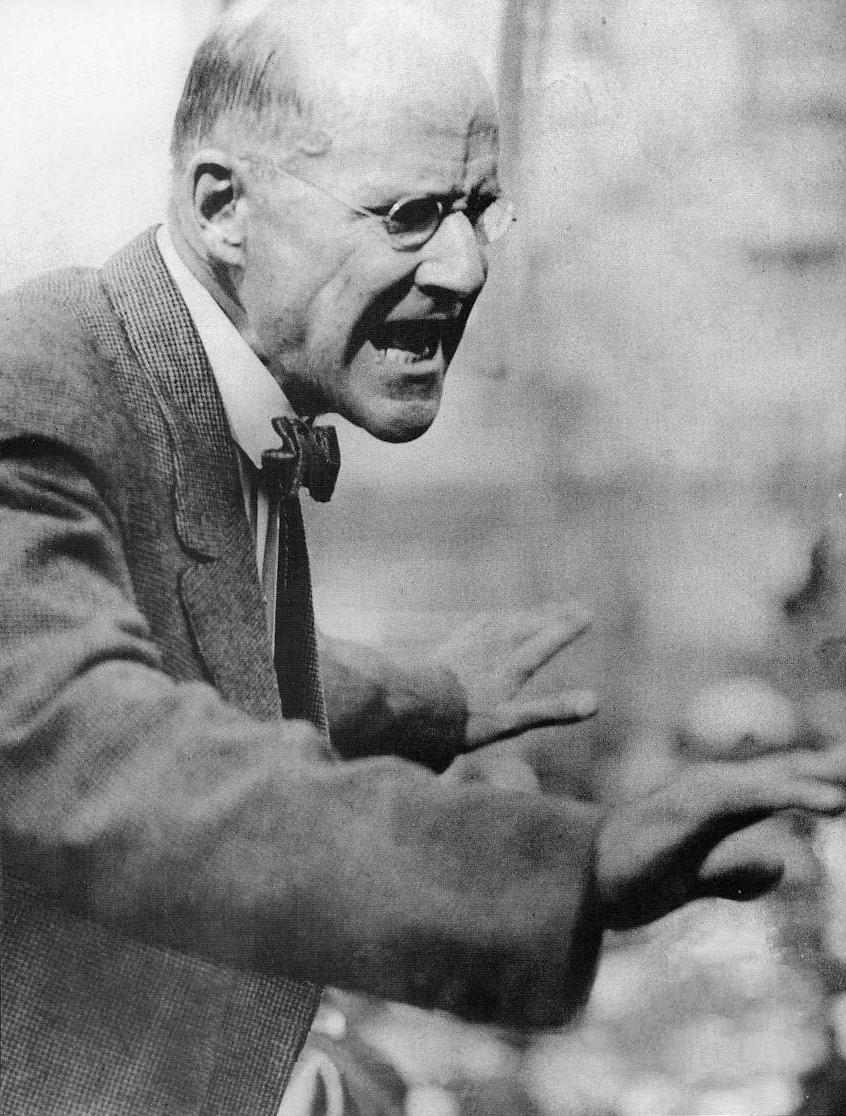
Eugene Debs – cofounder of the IWW and Socialist candidate
for
president 5 times

|
American Blacks also come under a new round of ethnic
hatred by alarmed Whites
... as Black Americans try to move out of their "place" at the
bottom of American
society
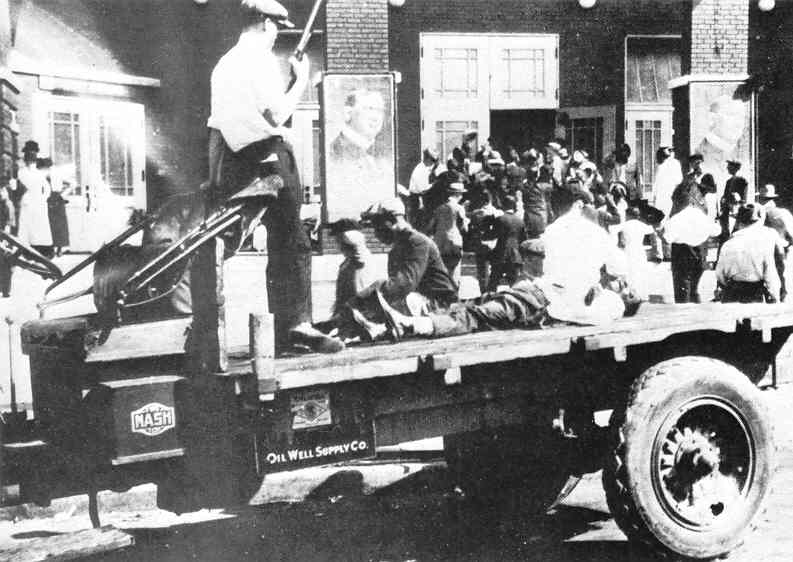
American Whites rounding up Blacks during the 1921 race riots
Lynching in Lawrenceville,
Georgia – 1920s
The lynching of Blacks in
Marion, Indiana – 1930

|
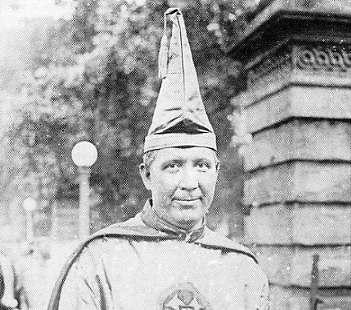
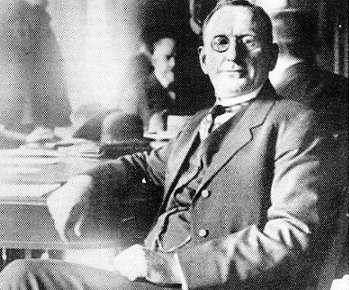
Imperial Wizards Hiram Evans and William Joseph Simmons
(The Klan was stronger in
the Midwest than the South; the governors of Oklahoma and Oregon
were
members and the government of the state of Indiana was practically run
by the Klan)
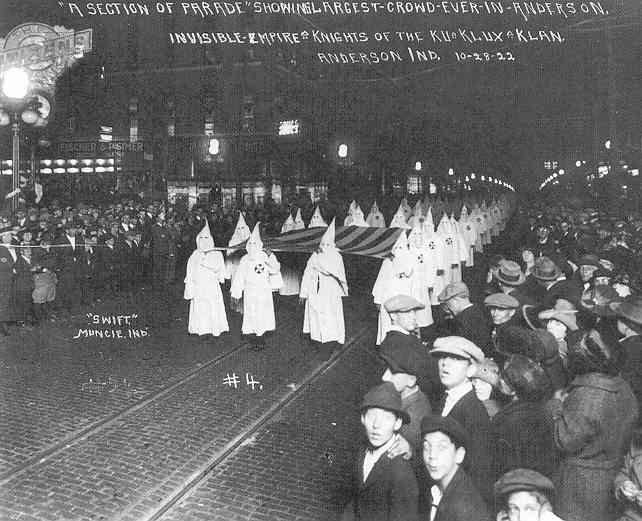
Klan Parade in Anderson,
Indiana – 1922
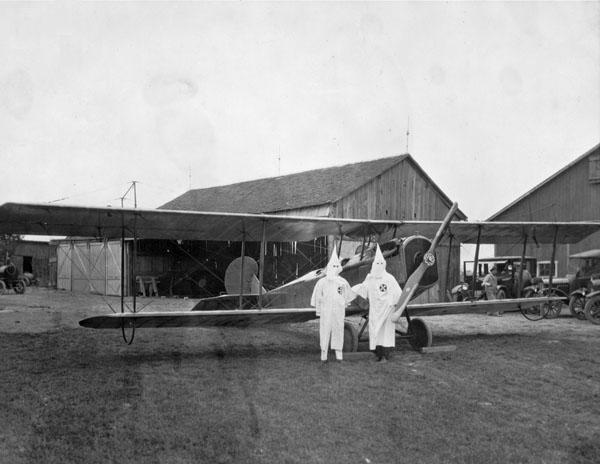
"Mysterious fliers who thrilled
a gathering of the K K K at a reception of
officers of [the]
Klan"
KKK marching in Washington,
DC – 1925
KKK marching in Washington, DC – 1925
An understandable response
of the virtually defenseless Blacks was a growth in the
"Back to Africa" movement
led by a rather colorful Marcus Garvey
Marcus Garvey reviewing paraders
for his "Back to Africa" movement – 1924

|
|
Darwinism as a
Major Cultural "Hot Button" But undoubtedly the most dramatic confrontation of the decade between the two cultures occurred over the issue of the teaching of Darwin's theory of evolution in the public schools. In 1925 the two sides, liberal urban America and conservative rural America met for something of a showdown in Dayton, Tennessee, over the question of teaching Darwinism in Tennessee’s public schools. The battle was over the fundamental question: was man descended, as Darwin stated, through the evolutionary process of natural selection ("survival of the fittest") from some early version of a primate (something of an early "monkey" specie) – or was he, as the Bible states, created fully as a man by God in a single event? The confrontation came to pass when in May of 1925, a group of Dayton civic leaders met at F.E. Robinson's Drugstore and decided to challenge Tennessee's new statute forbidding the teaching of Darwinist evolution. One motivation for holding the trial in Dayton was to revive the town's flagging economy. They knew that this would somehow put Dayton on everyone's map (and indeed it did!). The mastermind behind this event was George Washington Rappleyea, an engineer and geologist who managed the Cumberland Coal and Iron Company. Rappleyea was widely credited with suggesting that Dayton challenge the new anti-evolution statute. Cooperating in this venture was the twenty-four-year-old John Thomas Scopes. He was teaching at the local high school, his first job after graduating from the University of Kentucky in 1924. He taught algebra and physics, served as athletic coach, and occasionally substituted in biology classes at the Rhea County High School. The idea was that he would teach Darwinist biology – at least once – in violation of the state’s law prohibiting the teaching of Darwinism. This act would then set up the opportunity for the legal world in Tennessee to decide whether such a law was indeed constitutional. During the extremely hot summer of 1925 the "Scopes Monkey Trial" riveted the attention of the nation as newspapermen from all around the country crowded into the steaming courthouse to follow the trial. The old political warhorse, William Jennings Bryan, represented WASPish America, with its fervent dislike of Darwinism. Representing the Darwinists was Clarence
Darrow, the celebrity New York lawyer who had dazzled the nation with
his clever defense of two society boys who had killed a young
fourteen-year-old neighbor in order to see what it would be like to
commit the ultimate crime and to prove their Darwinian superiority
(Darrow blamed their actions on the extravagantly wealthy
socio-economic circumstances that had distorted their moral
sensitivities). Darrow also represented the fast-rising urban, secular
culture which ridiculed the superstition of the traditional Christian
culture. Backing up Darrow was the American Civil Liberties Union (ACLU), which was to become the leading voice behind a movement to replace WASPish Christianity with Secular-Humanism as America’s cultural-religious underpinning. Which side actually won the 1925 contest depended on the natural sympathies of the person giving answer to the question. From pulpits, anti-Darwinism seemed vindicated by the fact that the judge decided to support the law prohibiting the teaching of Darwinism in the Tennessee public schools. But the up-East urban newspapers celebrated the quite obvious (obvious to them anyway) intellectual victory of the scientific Darwinists over the superstitious, backwoods fantasies of the anti- Darwinists. Closing arguments were not allowed
(defense attorney Darrow refused and thus prosecuting attorney Bryan
was not permitted to do so either) and the sentence of guilty was
quickly decided in matters of only minutes on July 21. But Bryan
published his proposed closing argument subsequently. It is well worth
the read because it is actually prophetic:
|
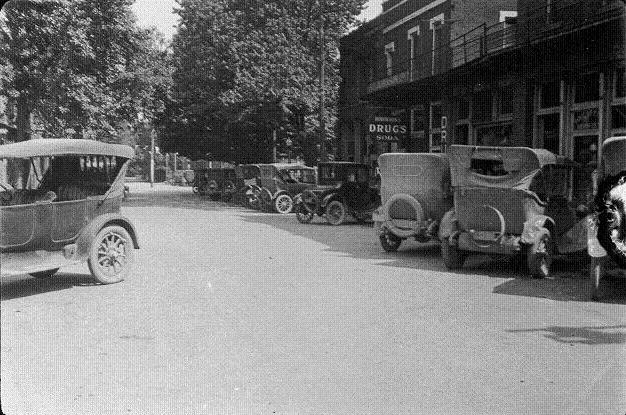
Downtown Dayton, Tennessee, June
1925.
Smithsonian Institution
Archives
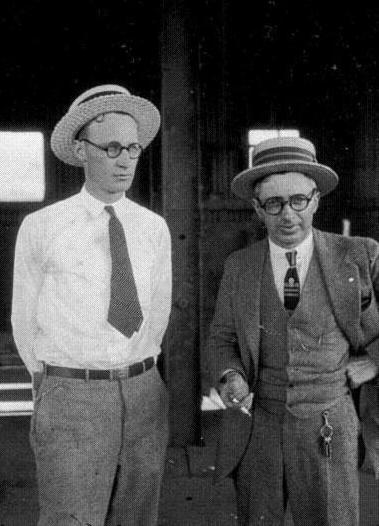
John Thomas Scopes (left) and George
Washington Rappleyea (right),
Dayton, Tennessee, June 1925.
Smithsonian Institution
Archives
ACLU lawyer Clarence Darrow with Leopold
and Loeb – 1924
Clarence Darrow arrives in
Dayton, Tennessee – 1925
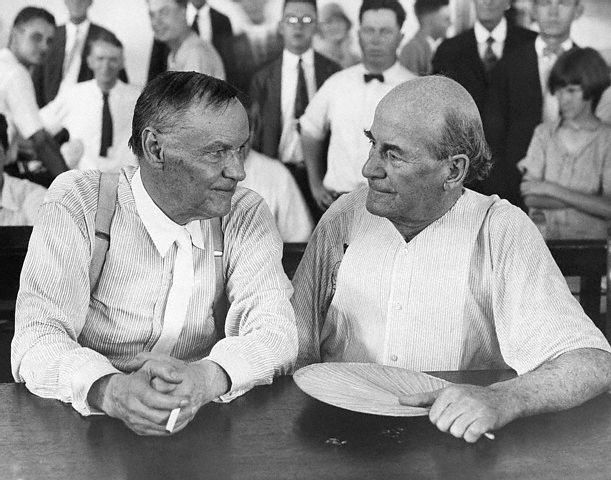
Clarence Darrow and William
Jennings Bryan in Dayton, Tennessee – 1925
Clarence Darrow looking over
papers during the Scopes Trial – 1925
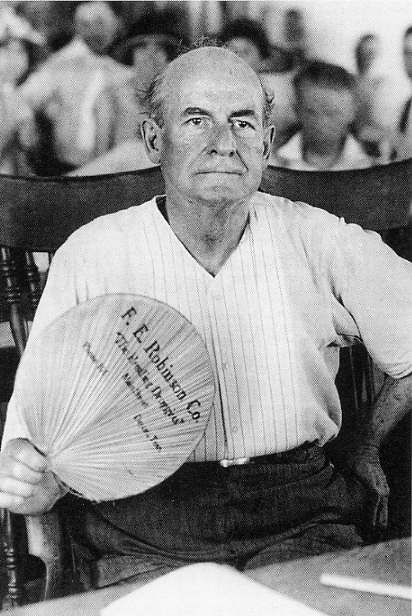
The old Christian war-horse,
William Jennings Bryan, at the Scopes "Monkey Trial" -
Dayton, Tennessee, summer
of 1925
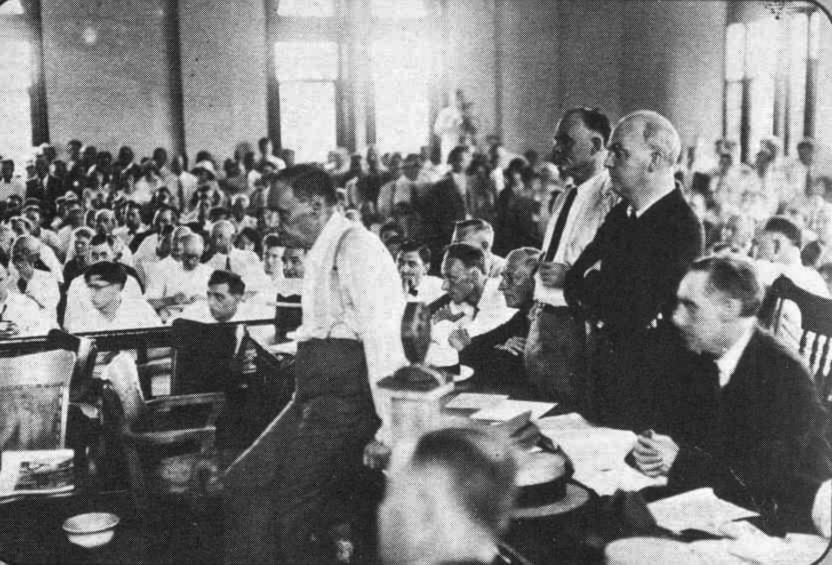
Clarence Darrow in the Dayton
courthouse – 1925
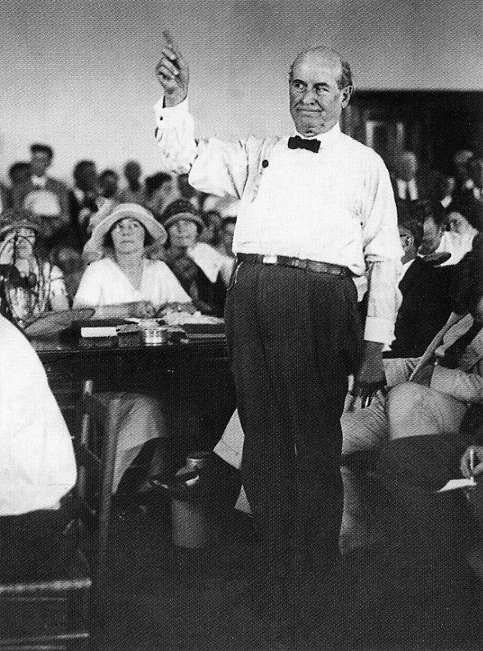
William Jennings Bryan defending
the Christian faith at the Scopes Monkey Trial
Bryan conferring during the
trial
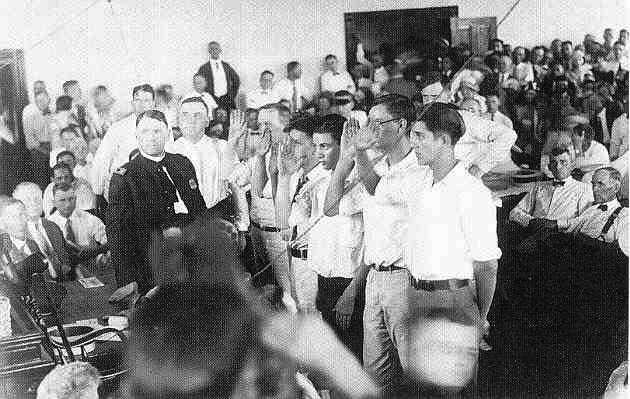
Students being sworn in as
witnesses at the trial
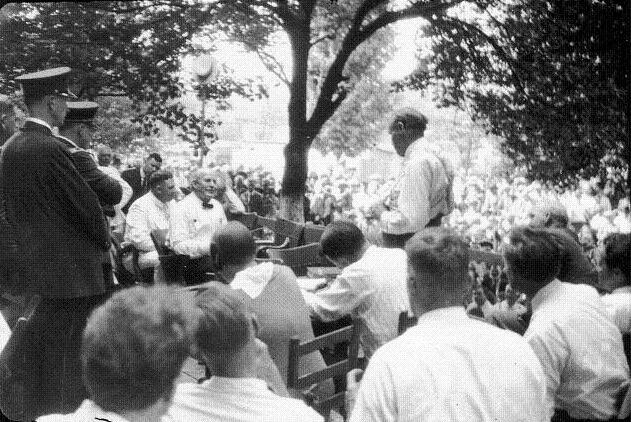
William Jennings Bryan under
examination by Clarence Darrow
(they moved the trial outside because of the stifling heat in the courtroom)
Smithsonian Institution
Archives

|
|
This deep urban-rural cultural divide also registered itself as a deepening split within the Christian community itself. There were a number of issues that were behind this split, though one, the matter of biblical inerrancy, was definitely the most important. Almost everything else about the Liberal-Fundamentalist split followed from the ongoing issue of biblical inerrancy. In the early 1900s the question of biblical inerrancy gathered force as a divisive issue, first within the Presbyterian denomination and then soon within the other mainline denominations. Heresy trials abounded as theologians and pastors lined up on one side or the other of the issue. For a time the Presbyterian denomination favored the Conservative view, demanding that all pastors adhere to five basic doctrines in order for their ordination to be in good standing with the denomination. But Liberals or "modernists" were gathering strength within the denomination. And with the unification with the Cumberland Presbyterian denomination, the Presbyterian Church shifted strongly toward the Liberal side of the debate. Meanwhile, Presbyterian layman, Lyman Stewart, sponsored a new series of publications entitled The Fundamentals published between 1910 and 1915. This would become a rallying point for a number of Conservative theologians of a wide number of Christian denominations. In 1915 the Conservative journal, The Presbyterian, finally published a declaration entitled "Back to Fundamentals." And thus the term '"Fundamentalist" was brought into greater use to describe Conservative Christian theology. At the same time the Liberal side of Christianity was taking a broader (Conservatives claimed shallower) approach to the faith, admitting that there was more than one road to God, that God’s love extended to the saved and unsaved alike, and that Christians ought to be more ecumenical among themselves (ignoring doctrinal differences among Christians of all types) and more accommodating in their outreach to other cultures.
On the other hand, one of the foremost of the believers in the Christian Fundam But the Liberal-Conservative balance of power was shifting within the Presbyterian denomination during the 1920s. When in 1928 the Presbyterian General Assembly voted to move Princeton from a traditionally Conservative theology to a more Liberal position, Machen and two other Princeton professors withdrew from the seminary to start a new one in nearby Philadelphia: Westminster Seminary.
|
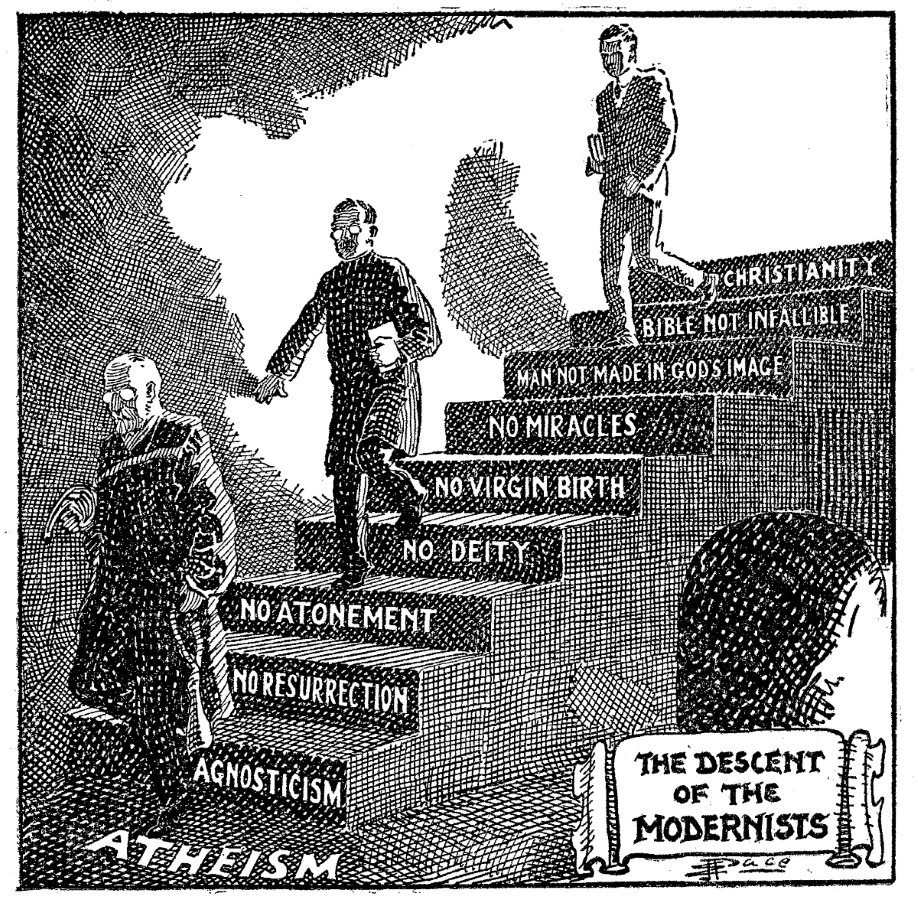
"The Descent
of the Modernists" by E.J. Pace (Christian Cartoons)
1922
|
|
Actually, all this fascination with the exciting world of massive materialism and unlimited personal freedom seemed at times even to urban America to exist simply to cover over a darker suspicion about life, a suspicion that lurked just below the surface of all this hoopla. The Great War – and its inevitable outcome of nothingness – had shaken the moral foundations of the American nation (as it did with every other participating nation) to the very core of what the society understood as being right and wrong. A form of cultural cynicism set in following the collapse of the Wilsonian dream in America. Many Americans (and Europeans) took the attitude that you had better enjoy life while you had it. "Eat, drink and be merry today because tomorrow you may die." Further, be wary of the high Idealism of those who want to invite you into some kind of higher world. Their world is only a fiction. The only world that really exists – or matters – is the one immediately in front of you. Such an attitude was considered being truly "realistic," and sophisticated. In keeping with this mood of rampant
cynicism, the general understanding was that there were no rights and
wrongs, only just human impulses that people needed to be socially free
to follow out. Whether these impulses were right or wrong (unless they
were obviously self-destructive) was a matter that no one was supposed
to be in a position to be a judge, either of themselves or of others. Thus free-thinking artists and intellectuals boasted of their escape from the intellectual tyrannies of excessive patriotism and superstitious piety. They proudly professed belief in nothing except the immediacy of their own personal existence – and were quick to mock those who held higher ideals, whether founded on the past or the future. Philosophically they referred to themselves sometimes as Humanists, sometimes as Existentialists – but always as scientific. But actually, as pure secularists (believing only in the reality of the immediately surrounding material order), they tended to be simply hedonistic cynics. They supported no causes – nor did they pay much attention to the social requirements of the larger social order. Those expected to lead the post-war societies got little or no support from this self-indulgent social group. The "Lost Generation"
Thus it was that despite all this freedom, despite the material glitz and glamor of the 1920s, there was beneath it all a spiritual emptiness, one that led Gertrude Stein – the grand patroness of the large number of American authors and poets who gathered in Paris to search for meaning to life – to call her literary flock gathered there the "Lost Generation." This group included such Americans as Ernest Hemingway, F. Scott Fitzgerald, John Dos Passos, E.E. Cummings, and Dorothy Parker. The pointless brutality of the war had stolen from this generation the optimism that had characterized Western culture during the Progressivist Era. True, the material level that the people were able to live at was unparalleled in history. But this now seemed to be very small comfort to these intellectuals, who felt the necessity to plumb the depths of the human soul for some kind of new direction that would be worthy of the kind of commitment to life that they had felt before the war. But mostly they found no such direction or worth. The cynics. The spirit of these lost souls was summed up in such works as Hemmingway's The Sun Also Rises (1926) and Fitzgerald's This Side of Paradise (1920), The Beautiful and Damned (1922) and The Great Gatsby (1925). This last-mentioned novel was highly representative of this Jazz Age mood: behind all the wealth, the fast life, the visible material achievements was a spiritual emptiness and social confusion that results in the murder of the gifted but corrupt young Gatsby and the collapse of the small social group that had once surrounded the Great Gatsby. Likewise, Hemmingway's novels seem to turn on the issue of hopes that lead nowhere because of life's complex, countering circumstances that the human will seems unable to overcome. The "Reds." Meanwhile other intellectuals, repulsed by the failure of American Progressivism to deliver on its promises, turned to other philosophies in the hope that they might find something more substantial to build their social hopes on. Marxism proved to be particularly popular, as the news coming out of Red Communist Russia (tainted by careful manipulation of that news by the Communists themselves) seemed to be working quite well once the Russian Civil War was over and Lenin's Communists had full mastery over the Russian situation, moving the country from feudal backwardness into something quite modern – and quite humane because it was supposedly so very communal. To a group of socially empty intellectual Westerners, this certainly was bound to have a very, very strong appeal. |
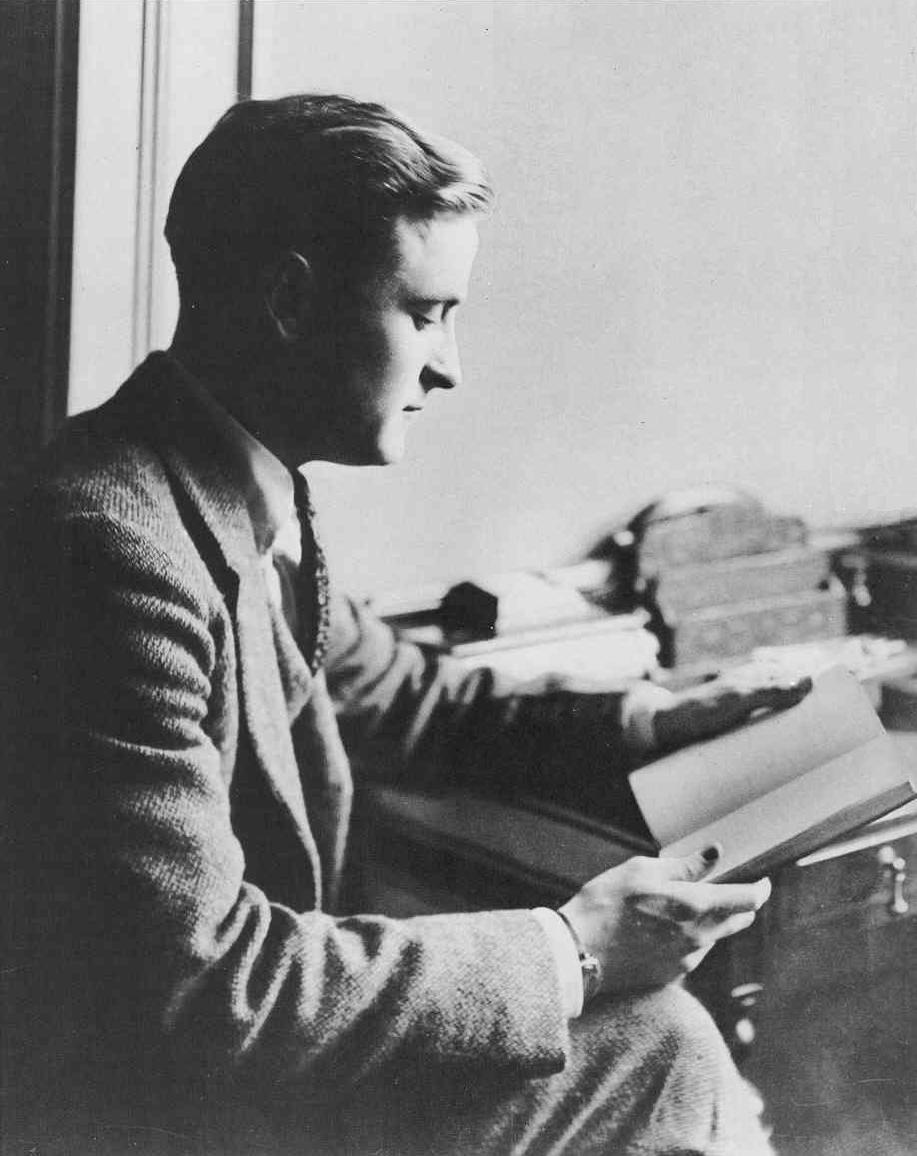
F. Scott
Fitzgerald
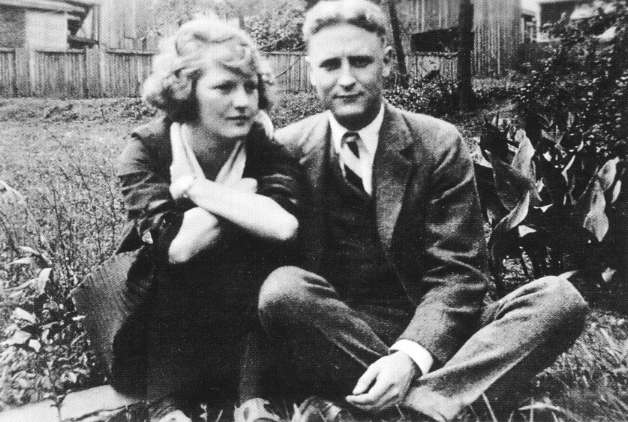
F. Scott and Zelda Fitzgerald
- models of Jazz Age flapperdom
Ernest
Hemmingway
H.L.Mencken
"Nobody ever went broke underestimating
the intelligence of the American public."
A witty and
outspoken
Baltimore
columnist / author / social-critic of national fame
in the 1910s and
1920s. In the 1930s his wit turned
bitter and he became an
arch-foe of FDR's New Deal

|
|
Freudian psychology explains and justifies the American mood
Then there was the degree of comforting logic that
seemingly could be found in the psychological theories of the Austrian
doctor Sigmund Freud. Though none of his theories were derived
through the exacting rigors of the scientific method by which the rest
of science accepted or rejected new truths, Freud's theories went
unquestioned in much of urban America – and in fact were widely
accepted as absolute Truth, because they made sense (when little else
did)! That is to say, Freud's speculations about the motives and
behaviors of humans seemed to offer an explanation to a culture, to a
lifestyle, to a worldview that otherwise seemed shallow and mindless
and beneath the dignity of human reason. Freud revived some element of
hope that what the post-war, post-Christian culture was doing was
actually logical. Basically, Freud explained that we humans did
things that made no sense because we were driven by even deeper,
unexplored urges that ran beneath the level of what our conscious minds
were capable of understanding and thus directing our actions in a
logical manner. Freud speculated that these subconscious urges were
formed in our early childhood out of sexual urges that had to be
repressed in order to form us into reasonably well-functioning social
creatures – that is, responsible members of society. Freud held to the
idea that by going back in our earliest memories and revisiting the
events of our early childhood that were part of this repressive
experience, we might be freed from such repression, and find indeed
fuller, more rewarding lives socially than the ones we were typically
experiencing during the Roaring Twenties! Freud mocked the idea of there being any
ultimate truths that directed human existence, only socially useful
ideas by which we humans were indoctrinated into society. Religion was
chief among these socially useful ideas. Religion in itself could not
be said to be true, for in exploring the many religious beliefs around
the world it became clear to Freud (and most other intellectuals of
those days) that the truths of religion were simply cultural
explanations offered as comfort (such as Santa Claus and the Easter
Bunny) to societies trying to make logical sense of an existence that
otherwise had no particular logic to it. In short, to Freud, religion
was a neurosis, or a useful illusion we fed ourselves in order to
comfort ourselves in the face of a very difficult existence. To Freud,
and to the hundreds of thousands of hip (cool) Freudian followers that
believed Freud to be the supreme prophet of modern times, religion in
itself was completely unrelated to Truth, and indeed was the source of
some of the most illogical and cruel of human acts in history.4 However the followers of Freud failed to
observe the fact that Freudian psychology itself was valued so highly
by them only because "it made sense," ... which thus put Freudianism in
the same category as the religions Freud mocked because they could be
said to be true only because they too made sense to their religious
followers. Freud himself made it clear that just because something made
sense did not make it true. It merely made it socially useful. And thus it was that Freudian followers
followed Freud religiously! Indeed, in all this, Freud and his Freudian
followers were helping to construct a new cultural Truth, contributing
greatly to a new post-Christian religion within Western society, the
Secular Humanism that was sweeping the intellectual circles of Europe
and America.
4Certainly
to the followers of Freud, the experience of the recent "Great War"
exposed such dangerous religious folly, in that each of the contending
parties in the war claimed "Gott mit uns" (God is with us). Surely God
was with no one during the war, unless God was indeed some kind of
cruel monster delighting in watching "God-fearing" soldiers slaughter
other "God-fearing" soldiers in vast numbers.
|
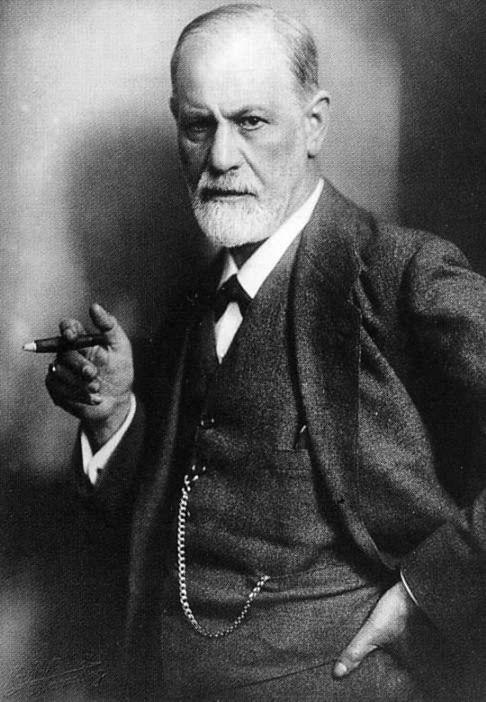
Austrian psychiatrist Dr. Sigmund Freud (1856-1939)


 Miles
H. Hodges
Miles
H. Hodges